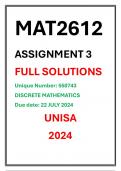Other
MAT2612 Assignment 3 Complete Solutions Unisa 2024 Discrete Mathematics Due date 22 July 2024
- Institution
- University Of South Africa (Unisa)
MAT2612 Assignment 3 Complete Solutions Unisa 2024 Discrete Mathematics Due date 22 July 2024
[Show more]




